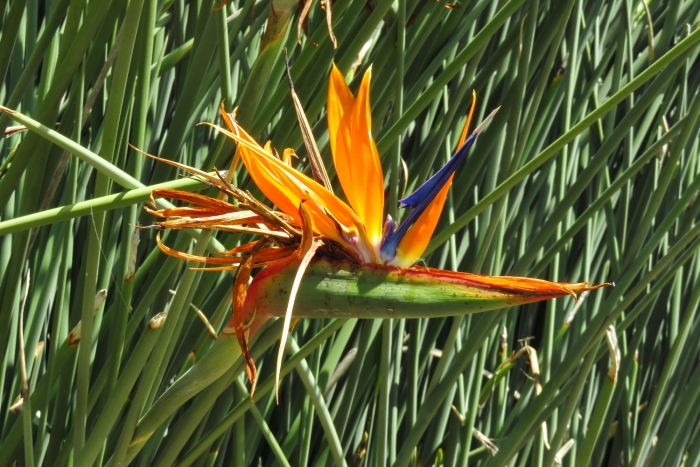Narrow-Leaved Bird Of Paradise
(Strelitzia juncea)
Narrow-Leaved Bird Of Paradise (Strelitzia juncea)
/
/

Vahe Martirosyan
CC BY-SA 2.0
Image By:
Vahe Martirosyan
Recorded By:
Copyright:
CC BY-SA 2.0
Copyright Notice:
Photo by: Vahe Martirosyan | License Type: CC BY-SA 2.0 | License URL: https://creativecommons.org/licenses/by/2.0/ | Uploader: Vahe Martirosyan | Publisher: Flickr |



























Estimated Native Range
Summary
Strelitzia juncea, commonly known as Narrow-leaved Bird of Paradise, is an evergreen perennial herb native to the Cape Province of South Africa, where it thrives in the dry, open grasslands and rocky outcrops. It is a slow-growing plant that can reach up to 6.6 feet (2 meters) in height, with a spread of 2-3 feet (0.6-0.9 meters). Unlike its relative, Strelitzia reginae, this species does not have the typical broad banana-like leaves but instead has reed-like leafless stalks, which makes it highly distinctive. The flowers resemble a bird’s head and beak, with striking orange and blue colors, and are quite showy when they bloom from late fall to late spring.
Strelitzia juncea is valued for its unique foliage and showy flowers, which make it a popular choice for ornamental use in xeriscaping, rock gardens, and as a focal point in drought-tolerant landscapes. It is also used in containers and atriums where its vertical form can be appreciated. This species requires minimal maintenance and is known for its tolerance to drought and moderate frost, although it should be protected from severe frost. It is susceptible to root rot if overwatered and may be affected by mealybugs and scale insects. Propagation is typically through division of clumps or from seed, though seed-grown plants take several years to flower.CC BY-SA 4.0
Strelitzia juncea is valued for its unique foliage and showy flowers, which make it a popular choice for ornamental use in xeriscaping, rock gardens, and as a focal point in drought-tolerant landscapes. It is also used in containers and atriums where its vertical form can be appreciated. This species requires minimal maintenance and is known for its tolerance to drought and moderate frost, although it should be protected from severe frost. It is susceptible to root rot if overwatered and may be affected by mealybugs and scale insects. Propagation is typically through division of clumps or from seed, though seed-grown plants take several years to flower.CC BY-SA 4.0
Plant Description
- Plant Type: Herb
- Height: 3.4-6 feet
- Width: 3-5 feet
- Growth Rate: Slow
- Flower Color: Orange, Blue
- Flowering Season: Fall, Spring, Summer
- Leaf Retention: Evergreen
Growth Requirements
- Sun: Full Sun, Part Shade
- Water: Low
- Drainage: Medium
Common Uses
Bird Garden, Drought Tolerant, Low Maintenance, Showy Flowers
Natural Habitat
native to the Cape Province of South Africa, where it thrives in the dry, open grasslands and rocky outcrops
Other Names
Common Names: Crane Flower, Strelitzia, Liten Papegojblomma
Scientific Names: , Strelitzia juncea, Strelitzia reginae var. juncea, Strelitzia parvifolia var. juncea, Strelitzia principis, Strelitzia reginae subsp. juncea, Strelitzia teretifolia, Strelitzia teretifolia publ,
GBIF Accepted Name: Strelitzia juncea (Ker Gawl.) Link